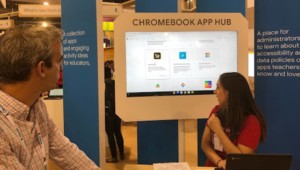Google Apps Summer Camp: Chromebooks

I know what you’re thinking, a Chromebook isn’t a Google App. But hosting a blog series about Google Apps for Education without featuring Google’s portable web-based computing device would be like teaching you how to build a house without introducing you to a hammer or nails. While Google’s workflow suite is accessible on any device with a web browser, utilizing Google Apps for Education (GAfE) is optimized with a Chromebook, or Chromebooks for that matter. So, to conclude this Summer Camp series, let me introduce you to the device that is bringing the power of the web to K-12 classrooms.
For those unfamiliar, a Chromebook is a unique class of personal computer which runs on the Google Chrome web browser. It combines “the functionality of a traditional notebook computer with the convenience of a pure-cloud client in a device the size of a netbook.” Getting to the bottom line, Chromebooks are also viable and incredibly cost-effective options for 1:1 classroom initiatives; the leading competitor to iPads in education.
With Chromebooks, each student has his or her own login account and can customize it to his or her liking. Additionally, multiple accounts can be created on a single device, so Chromebooks can be shared between groups of students or even classes within a school. When used with GAfE, Chromebooks empower students and teachers to create, store, and share content in the Cloud via Google Drive, seriously cutting down on material costs while increasing engagement and workflow.
After surveying early adopters of Chromebooks in K-12 classrooms for a research firm, Bob O’Donnell found that, “Chromebooks’ more reliable operation significantly reduced time lost in the classroom due to PC downtime, help desk calls, and operating system maintenance, . . .[which] translated to an average savings of $84 per device in productivity.”
Similarly, transitioning to and from using the device in a blended learning environment is streamlined by simply opening and closing the lid. Chromebooks are designed to boot up in no more than eight seconds each time, allowing learning to continue uninterrupted throughout the school day.
At the macro level, making the move to Chromebook deployments throughout a district is relatively simple as well. In a school district in Wisconsin, two employees unpackaged and configured 500 Chromebooks in three days, saying, “They’re easy to set up: Just press ‘control, alt, e’ and they’re ready for a student.”
From the administrator’s console, various access levels and controls can be set for deployment and added control. In addition to setting permissions for sharing inside or outside of the network, Chromebook administrators within a district can also blacklist inappropriate websites or apps while similarly pushing preferred tools out to the district’s devices instantly.
In a 2013 interview, Jason Markey, principal of East Leyden High School, said, “It’s been a year since Chromebooks were first distributed, and no one has gotten a virus or had a serious issue . . . there is nothing [in the Chrome operating system] for a virus to attach itself to.” Markey went on to add, “There’s been no need to hire any additional technicians, so we’ve been able to focus our resources on student learning rather than on supporting technology.”
With Google’s new learning management software, Classroom, set to debut this fall, the relative value of Chromebooks in the classroom will rise, without question. In order to meet the demands of a Chromebook initiative, experience suggests that teachers receive upwards to 24 hours of professional development support beforehand in order to become competent ‘Chromies.’
Richland School District Two in Columbia, SC adopted the Technological Pedagogical Content Knowledge (TPACK) framework along with the SAMR model of technology integration to aid in their successful Chromebook roll-out.
Two years into the initiative, one district representative says that Richland Two has seen “significant gains in the educational experience.” A recent The Journal article says that “Students feel more engaged. Teachers report they feel the Chromebooks and the use of Google Apps enhance the way they teach, what they teach, and the way students learn.” And most importantly, “Teaching and learning is becoming more collaborative” with Chromebooks in the classroom.





Jim Windisch
Thanks for sharing this, Dave. My school is getting a mobile lab of Chromebooks next year and I can't wait! I've been an avid "Chromie" for years and just made the jump to personally using a Chromebook this winter. I'm intrigued by the idea that each Chromebook saves $84 of productivity costs.
I'll share your Google Apps Summer Camp with the staff at my school and I'll be sure to tweet (@teacherwithtuba) and write a few blog posts about all of the things we end up using our Chromebooks for.